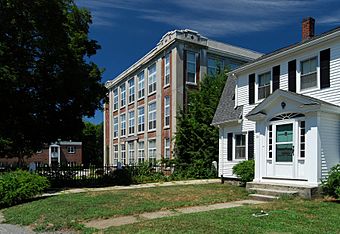Shawsheen Village Historic District facts for kids
Quick facts for kids |
|
|
Shawsheen Village Historic District
|
|

A house and factory building in Shawsheen Village
|
|
| Location | Andover, Massachusetts |
|---|---|
| Built | 1919 |
| Architect | multiple |
| Architectural style | Colonial Revival, Tudor Revival |
| NRHP reference No. | 79000328 |
| Added to NRHP | February 9, 1979 |
The Shawsheen Village Historic District is a special neighborhood in northern Andover, Massachusetts. It was built in the early 1920s as a "planned community" by a company. This means the whole village was designed and built by one company for its workers.
The idea for Shawsheen Village came from William Madison Wood. He was the head of the American Woolen Company. This company made woolen fabrics. A team of architects helped design the village. These included Adden & Parker, Clifford Allbright, Ripley and LeBoutillier, and James E. Allen. John Franklin, a civil engineer for the company, also helped design the village under Wood's guidance.
The village included many different buildings. There was a train station, shops, apartment buildings, and factories. It also had parks and many houses for families. Shawsheen Village was built close to the company's main factories in Lawrence. Some older houses from a settlement called Frye Village were also moved and included in the new design.
Contents
Exploring Shawsheen Village: What Was It Like?
Shawsheen Village was divided into three main parts. Each part had a different purpose.
The Village Center: Shops and Services
The western part of the village was the main center. It was located where Main Street (Massachusetts Route 28) met Lowell Street and Haverhill Street (Massachusetts Route 133). This area had all the important services. You could find shops here to buy things. There was also a post office for sending mail.
The Industrial Area: Where Work Happened
Just east of the village center, closer to the Shawsheen River, was the industrial area. This is where the factories and other work buildings were located. It was the heart of the company's operations within the village.
Homes for Everyone: Different Neighborhoods
The village had two main residential areas for people to live.
- One area was mostly north and west of the center. This part had homes for the company's top managers and executives. These houses were likely larger and more fancy.
- The third area was east and south of the industrial part. It even crossed the railroad tracks and the river. This section had homes for middle-class workers. These houses were probably smaller but still comfortable.
Some old houses from the original Frye Village were moved and placed throughout these neighborhoods. This helped blend the old history with the new planned community.
The End of a Company Town
Even though Shawsheen Village was well-planned, it didn't last long as a company-owned town. William Wood, the founder, passed away in 1926. After he died, the idea of the company owning everything started to change.
By 1932, most of the company's properties were bought by a special trust. This trust then sold the properties, often to the people who were already living in them. This meant that families could now own their homes instead of renting from the company.
The Shawsheen Village Historic District was officially added to the National Register of Historic Places in 1979. This means it's recognized as an important historical place.



